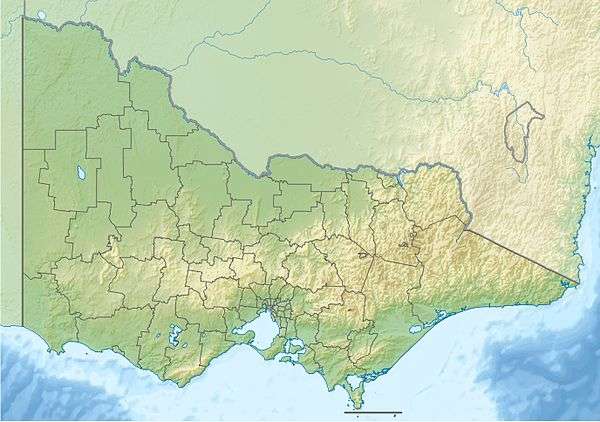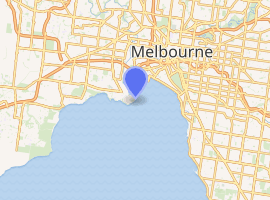Williamstown Lighthouse
The Williamstown Lighthouse is situated at Point Gellibrand, in the Melbourne suburb of Williamstown.
Timeball tower. | |
 Victoria | |

| |
| Location | Williamstown Victoria Australia |
|---|---|
| Coordinates | 37°52′00.6″S 144°54′45.7″E |
| Year first constructed | 1840 (first) 1849 (second) 1934 (third) |
| Automated | 1934 |
| Deactivated | 1849 (first) 1859 (second) 1987 (third) |
| Construction | wooden tower (first) bluestone tower (second and third) |
| Tower shape | quadrangular tower with time ball mast |
| Markings / pattern | unpainted tower |
| Tower height | 17 metres (56 ft) |
| Focal height | 22 metres (72 ft) |
| Light source | mains power |
| Range | 15 nautical miles (28 km; 17 mi) |
| Characteristic | Fl GR 7.5s. (as lighthouse 1934-1987)[1] |
| Managing agent | Parks Victoria |
| Heritage | listed on the Victorian Heritage Register |
History
It was erected in 1852, with an unusual square form, and replaced earlier navigational aids established from the time of the first settlement in 1835. It is 17 metres high, and situated on an elevation of 22 metres. Built of local basalt, it is the second oldest lighthouse in Victoria after the Cape Otway Lighthouse.
The first lighthouse on the site was built in 1839–40. This timber structure was replaced with a square bluestone lighthouse tower, designed by Henry Ginn. The bluestone section has battered lower stories featuring rusticated masonry with smooth string courses and originally had a castellated parapet with mast and spherical, copper plate timeball above. The masonry was quarried and worked by prisoner labour. Four lamps were shining in May 1849; a larger lamp was installed in August 1849.
A timeball apparatus mounted on top of the bluestone tower operated regularly until 1926. Its original use was as a signalling device to ships. From 1858 until 1926 the large ball on the top was dropped each afternoon at one o'clock to allow shipmasters moored offshore to correct their chronometers. The Timeball Tower/Lighthouse had an additional time signal at eight o'clock each night by means of eclipsing the lantern of the lighthouse.
The timeball ceased to operate in August 1926 and the apparatus was dismantled. In 1932, the Timeball Tower was adapted for use as a lighthouse by increasing the height to 98 feet by the addition of a circular brick tower 30 feet in height. A large copper ball encircled the mast and rested in a catcher cup of iron when not in use. The lighthouse operated in this fashion until 1987. In 1989, the circular brick tower was removed by the Williamstown Historical Society so that the square tower could be restored and the timeball apparatus replaced.
References
- Williamstown Lighthouse Lighthouses of Australia Inc.
- Rowlett, Russ. "Lighthouses of Australia: Victoria". The Lighthouse Directory. University of North Carolina at Chapel Hill. Retrieved 24 July 2008.
| Wikimedia Commons has media related to Williamstown Lighthouse. |